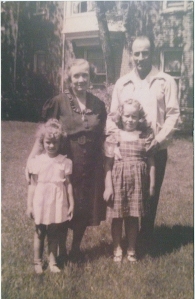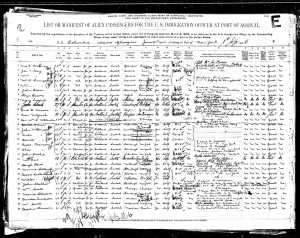
Eliza Laurie Roberts, back left, with her son, Walter, and her granddaughters, Susan (front, left) and Sandra. This picture was taken about 1950, at the Montana State Hospital for the Insane at Warm Springs.
Additional developments and discoveries have completely renovated everything I thought I knew about Eliza and her journey. I’ve verified what I now know through at least three sources per fact.
This legacy, while heartbreaking, is the account of Eliza Laurie Roberts.
Then He said to them, “Beware, and be on your guard against every form of greed….” KJV, Luke 12:15
Eliza Laurie Roberts…. Here is what you know thus far: Eliza Laurie, born in Scotland in 1879, touched American soil in 1905. She lived at 107 N. C Street in Livingston, Montana, where she met Robert Roberts, brother of the duplex’s additional tenant, Edward. They married on January 16, 1907, and in September of that same year, she gave birth to their first son, Edward. In 1910, they welcomed another addition, Walter. On March 23, 1919, Nancy Roberts was born in Spokane, Washington. This brings us to our current post, titled “The Fall.” In the Livingston/Big Timber, MT City Directory for 1916, Robert Roberts is listed in the Farmer’s Index with 320 acres of land. At that time, it was valued at $4,324. Adjusted for inflation, his land would be approximately $91,212. William J. Hannah, his brother-in-law, was also listed in the index as a sheep rancher. His property acreage totaled 3,289 acres. His operation as assessed at a value of $18,556 (adj. for current value: $391,426). Hannah, however much he was worth, it appears he still had a lot to accomplish regarding the favor in the eyes of his peers. The Big Timber Pioneer newspaper rarely, if ever, says anything negative about it’s hometown boy. In fact, for decades on end, if one were to go by the Pioneer alone, all you would see would be excerpts singing his praises as a veteran or senator. Not all newspapers were quite so nice. Just a few years before the directory was taken, The Big Timber Express called Hannah a “jackass” and said that “when he dies, he will have left a trail of slime from the cradle to the grave.” Fans of Hannah were few, it seems. I’m generally a fan of giving any character a chance at redemption. And if someone comes to me today with new facts about Hannah that disproves what I have, I will gladly take it into consideration. But as it stands, the “worthless nincompoop” made his mark on the Roberts family. Eliza came back to Big Timber, that is a certainty: she became pregnant with Nancy in about July of 1918. In the City Directory for 1918, Robert Roberts is, again, found in the Farmer’s Index. He still has 320 acres of land, only now, the value has increased substantially. His farm has more than doubled in worth, coming in at $9,274. Today’s figure? $195,629. This hardly seems like the ‘failing crops’ tale that has been rehearsed for decades regarding Robert’s farm. During the winter months, however, not much will grow with inches of snow on it. Eliza and the boys headed off to Spokane as planned, her being pregnant, and the Spanish Influenza creeping up their doorstep. Robert fell ill and died on November 20, 1918. Enter W. J. Hannah. Roberts’ death was tragic – after all, he was only 37 years old, and had family – a wife with two young sons and a baby on the way. But his dear wife was 459 miles away. The moral thing to do would be to contact Eliza and tell her, immediately, of her husband’s tragic death. Eliza, being the surviving spouse, would have rights to the homestead since her husband had already secured a patent on the land. However…. Hannah, being the politician he was, apparently did not notify Eliza of her husband’s death. Spokane’s City Directories collected information for publication in November and December the year prior to publication. The 1919 directory would have information from November and December, year 1918. The 1919 directory, in the township and block Eliza can be found at, was collected at the end of December, around the 23rd. At the time, she listed the head of household as Robert J. Roberts; his occupation, farmer. The address was 114 E. Everett Avenue, Spokane – the same address her father and step-mother can be found at. Eliza did not yet know Robert had died, more than a month after his passing. This detail profoundly verifies Hannah’s angle – since that same month, December 1918, Hannah applied for Administration Privileges over Robert Roberts’ estate – one worth thousands. Neither Hannah’s farm, nor the value of it, could be found in the 1918 Farmer’s Index. He was listed as a renter, whereas Robert was a homeowner. Hannah’s authority was granted quickly, since he was quite a friend of the judge. The required public notice, meant to allow other family members the opportunity to petition the request, was ran the Pioneer the same day as the court’s declaration. Handy, huh? Robert died on November 20; Eliza, living in Spokane, and unaware of her husband’s death, and waiting on her husband to join their growing family in a new city. Imagine checking the mail as often as possible, trying to send word one way or another to your spouse, your husband of only 11 years, and having no way to do so. Eliza was pregnant, and unemployed in Spokane, living with her parents. One wonders if this was the angle Hannah used to acquire administrative rights to his brother-in-law’s estate…. Hannah took the 320 acres of Roberts’ farm, and everything on it, and either sold it or auctioned it off. While Eliza and her sons were still in Spokane, Hannah filed for legal guardianship of both of her sons. It was granted without complication. When she returned to Big Timber in April 1920 to bury her infant daughter, her sons were handed to Hannah. And Hannah handed Eliza to the Montana State Hospital for the Insane at Warm Springs. And there she would stay, locked away by money and greed, for decades. There is a photo I have framed next to my chair in the living room. In it, a woman about my height, with my nose, stands next to a handsome gentleman and two young girls. The oldest, standing in front of her father, is my grandmother, Sandra; the youngest, my great aunt, Susan. The woman of similar stature, Miss Eliza. The photo was taken during her time at Warm Springs. In the background, you can see a distinct building, somewhat resembling an apartment or dorm. It was a horrid place, full of the worst stories you could dream up – sterilizations meant to prevent the procreation of “feeble-minded, insane, and epileptics” were commonplace. I am in the process of requesting Eliza’s medical records from her time there to assess whether she was, indeed, one of those suscepted to such an act. In that photo, though, she is smiling. She appears as if she’s dressed for a Sunday morning church service, dainty and detailed. I assume the measure was for the benefit of the two young girls who joined their father for a visit. It could not have been the ideal location for a family outing. Edward (the younger) and his brother, Walter, Eliza’s sons, worked tirelessly to save the money for a lawyer and have Eliza declared ‘mentally fit’ for reentrance to society. They succeeded only a few years before she died, at age 64. Hannah went on to have four children, the youngest of whom was born in 1918. In 1921, Hannah was listed in the Pioneer’s Delinquent Tax List for a substantial amount. He died in 1947 in Denver, Colorado. The Big Timber Pioneer ran a front page obituary for Hannah, highlighting his service in the Spanish American War, his terms in the state legislature, his family and their contributions to the community. In 1963, Walter – Eliza’s youngest, and my great grandfather, died in Stuttgart, Arkansas. He is buried there at Lone Tree Cemetery. A year later, Eliza joined him. She was interred at Mountain View Cemetery in Big Timber, where her daughter was buried, and one can assume, her husband. There are no headstones for any of them. None of their deaths made the front page.
The Montana Memory Project has continued to update their previously deleted 1900s-1919 editions of The Big Timber Pioneer, which has allowed me to pinpoint dates, events, and places that ordinarily, I would never have been able to verify. I must first give them a big pat on the back for keeping the updating process running smoothly.







